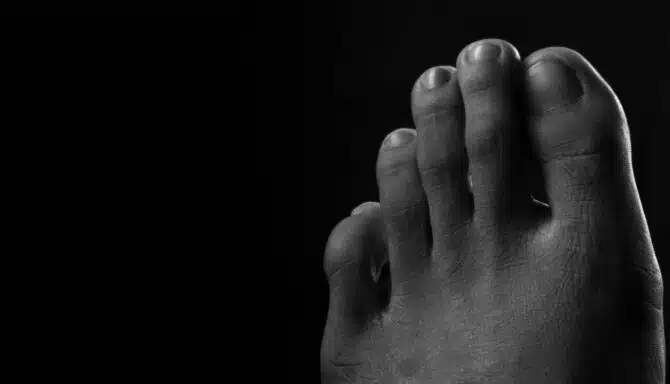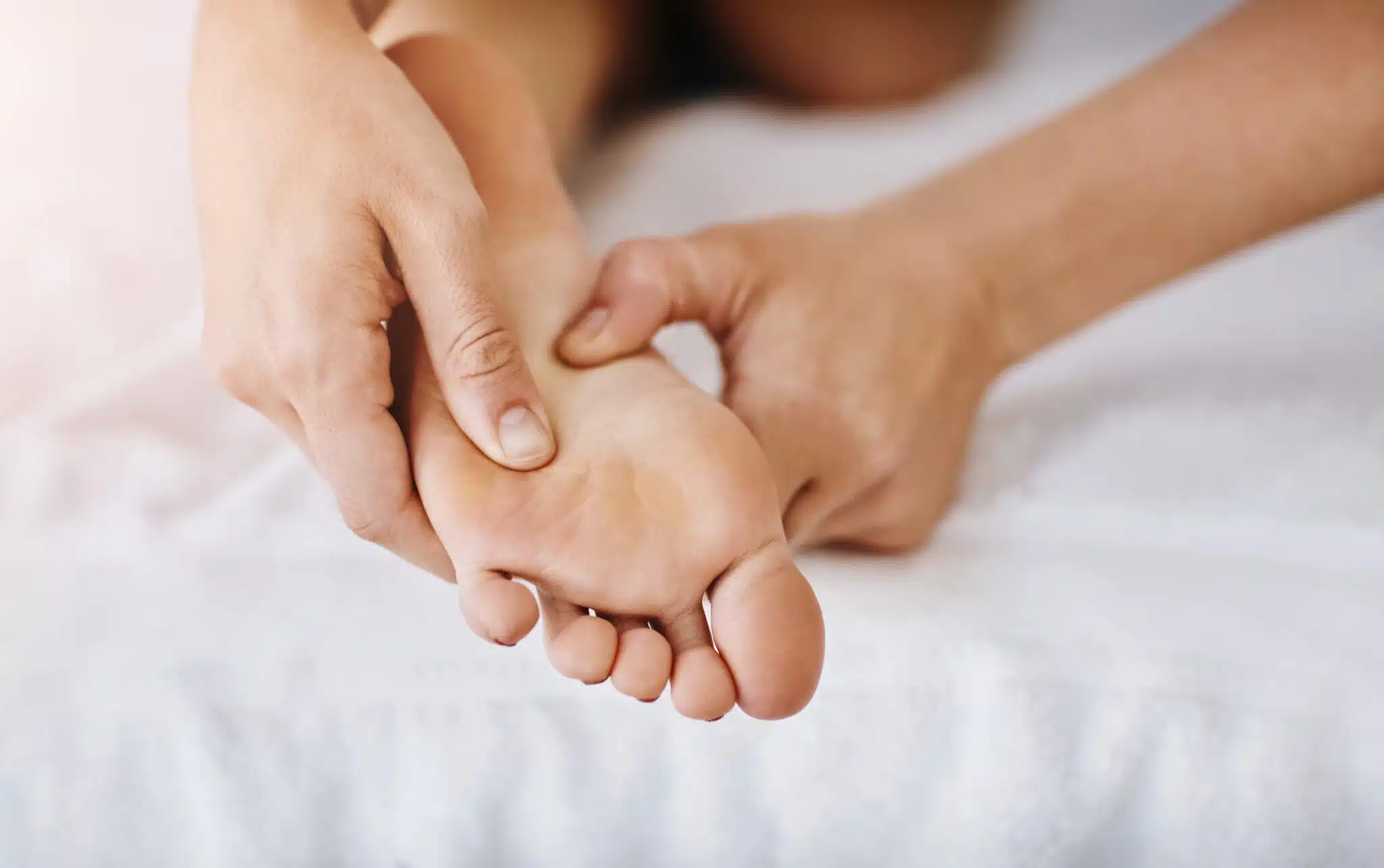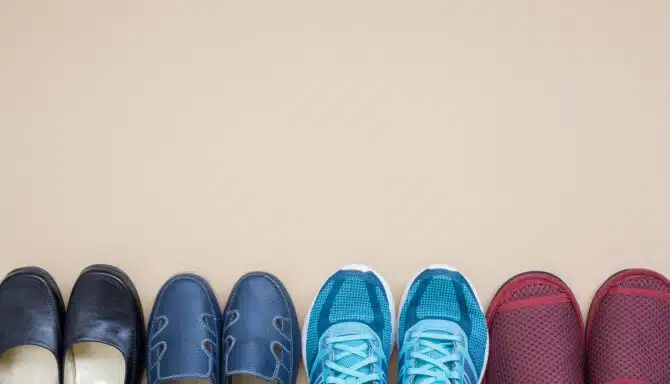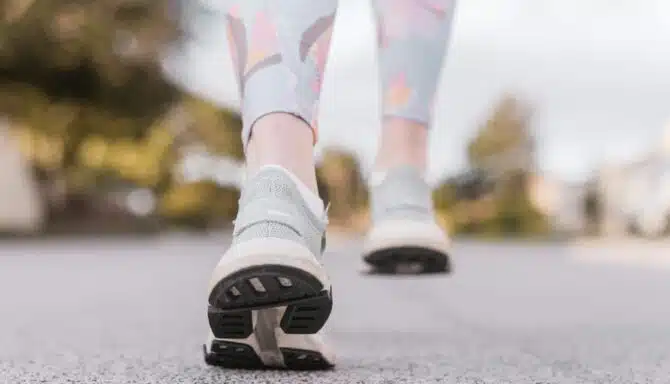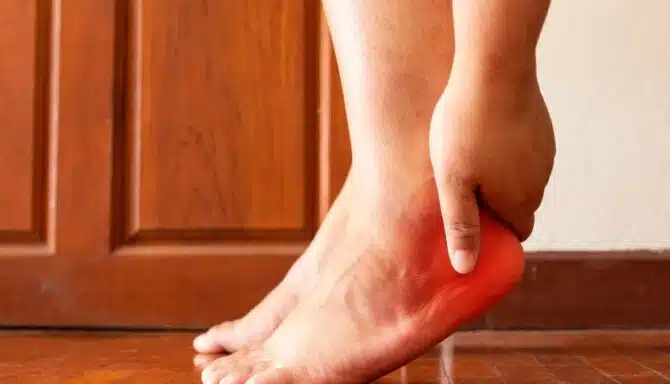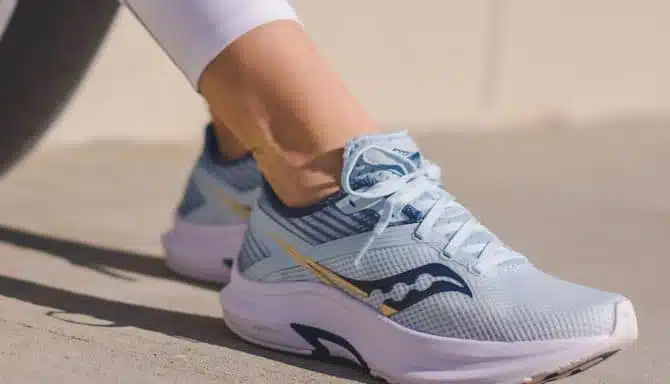July 18, 2024
Feet come in all shapes and sizes, and while many people have heard of common foot conditions like bunions or flat feet, there's another lesser-known but equally interesting foot characteristic called Morton's foot or Morton's toe.
The condition occurs when the second toe is longer than the big toe, leading to potential biomechanical implications and foot-related issues. Let's delve into Morton's Foot, its potential effects on foot health, and how to manage it.
What is Morton's foot/toe?
Morton's Foot, also known as Morton's toe/foot or Greek foot, is a foot structure in which the second toe is longer than the big toe. The big toe is the longest in a typical foot, followed by the second toe. (Despite sharing the same name, Morton's neuroma and Morton's toe are not the same.)
However, in individuals with Morton's foot, the second toe extends beyond the big toe, sometimes significantly. The condition is quite common. As many as 40%+ individuals have a longer second toe than a big toe.
Potential biomechanical implications
But here's the twist: while Morton's foot is generally considered a variation of normal foot anatomy rather than a medical condition, it can have some surprising biomechanical implications that affect gait and foot function. Let's explore these potential issues associated with Morton's foot.
Added pressure on the second toe
The longer second toe may bear more weight during walking or standing, leading to increased pressure and potential discomfort or pain in the ball of the foot, which may contribute to clawing of the toe and hammertoes.
Gait changes
Morton's foot can alter the distribution of weight and pressure across the foot, potentially affecting gait mechanics and posture. This may contribute to overpronation, increasing the risk of injuries such as plantar fasciitis, shin splints and bunions.
Footwear challenges
Finding the right footwear can be a real challenge for individuals with Morton's foot. Shoes often fail to comfortably accommodate the longer second toe, leading to issues such as rubbing, irritation, or the development of thickened or ingrown toenails, corns or calluses on the affected toe.
How to manage Morton's foot
While Morton's Foot may not require medical intervention, there are steps individuals can take to manage associated discomfort or mitigate potential issues proactively:
Choose footwear wisely. Opt for shoes with a wide toe box to comfortably accommodate the longer second toe—Asics is a great choice for a roomier and wider toe box. Avoid narrow or pointed shoes that can squeeze or crowd the toes.
Consider orthotic support. Custom orthotic inserts or insoles can offset pressure on the toes and support the foot. This can alleviate any discomfort associated with Morton's Foot and improve your overall foot mechanics.
Foot-strengthening exercises. Engaging in exercises to strengthen the muscles of the foot and ankle can help improve stability and support, reducing the risk of overuse injuries or discomfort associated with Morton's foot.
Regular foot care. Practicing good foot hygiene and monitoring for signs of irritation or injury can help prevent complications such as corns, calluses, or ingrown toenails on the longer second toe.
March 4, 2024
Similar to practicing exercises and stretches at home, learning how to perform your own foot massage and relaxation techniques can work wonders. Whether you’re looking to manage your own pain, or tending to a loved one, foot massages can provide comfort and stress relief.
Since foot massages are a major component of DIY foot care, we want to give you some handy tips on how to make the most of them. Let’s discuss how to massage each part of the foot, and highlight foot massage benefits you may not even be aware of!
Today's blog will explore:
Main benefits of a foot massage
Foot massage techniques
Additional benefits of a foot massage
Main Benefits of a Foot Massage
Foot massages can be empowering for those on a pain management journey. Regularly performing them before bed and when you wake up adds value to your treatment plan, and can make your daily life more comfortable! Here are the numerous benefits:
Targeted treatment of foot conditions
Relaxation and stress relief
Swelling (edema) management
Restless leg syndrome management
Reduces foot fatigue and boosts energy
Improves blood circulation
Foot Massages Techniques
A comprehensive foot massage should target as much of the foot as possible, but sometimes foot pain and conditions tend to affect certain areas and you want to focus on what you're struggling with.
Heel
Can help with plantar fasciitis, Achilles' tendonitis, etc.
Apply gentle pressure to the heel, using circular motions with your thumbs to loosen up the area.
Foot Arch / Bottom of the Foot
Can help with flat feet, high arches, metatarsalgia, etc.
While standing, place your arch on top of a therapeutic massage ball, and roll back and forth. This doubles as a useful foot exercise!
Use your knuckles to knead and massage the arch in a back-and-forth motion.
Apply firm yet comfortable pressure with your thumbs in small circular motions, addressing as much tension as possible.
Toes
Can help with arthritis, bunions, etc.
Apply a light, pinching motion to the base of each toe, working your way towards the tip.
Use your thumbs to press and release along the toe joints, addressing any tension.
Gently pull each toe away from the foot until you feel a subtle stretch.
Top of the Foot
Can help with extensor tendonitis, arthritis, stress fractures, etc.
Apply gentle pressure with your thumbs along the top of the foot, from the base of the toes to the ankle.
Use your knuckles or thumbs to knead the area in small circular motions, focusing on any tightness or tension.
Incorporate long, sweeping strokes with your palms, moving from the toes towards the ankle.
Additional Benefits of a Foot Massage
You may also find acupressure points in the feet and foot reflexology worth exploring.
Some studies suggest that “meridian points on the feet correspond with various organs in the body,” which is the concept behind foot reflexology. These organs include the kidneys, liver, small intestine, and many more. Essentially, applying gentle pressure to the appropriate acupressure points is believed to stimulate the flow of energy along the body's meridians.
In addition to pain management and stress relief, foot reflexology may also help with sleep, digestion, and eyesight. Your DIY massages may somewhat reflect what reflexology can achieve, but it’s important to discuss the concept with a healthcare professional if it interests you.
December 18, 2023
Compared to other purchases, shoes warrant a lot of thought and consideration. Wearing improper footwear is directly linked to foot pain and can turn into debilitating foot conditions. These conditions range from musculoskeletal pain (pain in the joints, muscles, ligaments and bones) to debilitating skin and nail issues. In other words, forcing your feet to operate in an inhospitable environment is a recipe for disaster!
Let’s take a look at how your bad shoes are causing you discomfort, and learn about some of the best solutions for foot pain and footwear-related health tips.
Image Credit: iStock
Why Does Improper Footwear Cause Foot Pain?
Research suggests that between 63 and 72% of people with foot pain wear shoes that are too small, too narrow and too cramped in the toe box. They also often lack the right amount of arch support, cushioning and protection from the ground’s impact. Studies also show that wearing poor shoes for decades can be a major reason why seniors experience foot pain today!
In a nutshell, inadequate footwear can ultimately disrupt the biomechanics of the feet, resulting in persistent pain and potential long-term damage.
Image Credit: iStock
Foot Conditions and Wearing Improper Footwear
From severe toenail pain, to dull aches, to nagging skin irritation, bad shoes can cause pain in more ways than one. Here are just a few issues you may be struggling with today:
Bunions and Hammertoes: Caused by narrow toe boxes and high heels.
Plantar fasciitis: Caused or contributed to by a lack of arch support.
Ingrown toenails: Can occur due to tight and narrow shoes that disrupt normal nail growth patterns.
Blisters: Due to a lack of cushioning and excessive rubbing against the skin.
Achilles Tendonitis: Contributed to by inadequate heel and arch support.
Diabetic foot: Ill-fitting shoes can lead to an increase in vulnerable pressure points, reduced blood circulation, and heightened risk of foot ulcers.
Please note that some conditions may be so advanced that they require medical shoes or orthopaedic shoes.
Image Credit: iStock
Revamping Footwear and Foot Health Tips
There are a few different ways to find comfortable footwear. First, you can try a shoe fitting service at Feet First Clinic. A staff member will guide you through available options and answer any questions you may have (staff members at regular shoe stores are often unable to answer these questions properly!).
Or, you can book a full footwear assessment and video gait analysis with a chiropodist. This gives you more insight into how you carry your weight and what parts of your feet need the most support.
If you choose to venture out on your own entirely, check out this checklist before you go shopping!
Lastly, you can double up on protection by investing in custom orthotics and wearing them with shoes that come with removable insoles.
Image Credit: iStock
December 5, 2022
Walking is one of the best forms of exercise. Walking is low-impact; it doesn't require fancy or expensive equipment, helps improve blood flow, and can lower blood pressure, amongst other benefits. Fundamentally, walking is how we get around.
Because we rely on this form of movement, we must keep our feet healthy to ensure walking is pain-free. However, the feet are complex, and some foot conditions may make walking painful or uncomfortable. The foot contains more than 25 bones. More broadly, the foot splits into three sections: the toes, the midfoot, and the heel and low ankle. The foot's various bones and muscles need to work in unison. If not, biomechanical abnormalities can cause multiple foot conditions.
This article explores five main reasons why your feet hurt when walking.
Common foot conditions
Plantar fasciitis
If you experience pain in the heel of your foot, it could be plantar fasciitis. The plantar fascia is a band of tissue (called the fascia) that runs along the bottom of the foot. The fascia connects the heel of the foot to your toes. Pain when walking would be felt within the bottom of the foot, specifically the underside of your heel.
Since most people heel strike (I.e., the first body part to touch the ground), much of the impact of walking or running is in the plantar. The band can tear, swell, and inflame when the plantar fascia becomes overloaded or damaged.
Plantar fasciitis develops over time rather than being an acute injury. If recognized early, treatment can be as simple as rest and icing. Early signs and symptoms include a dull pain in the heel of the foot and bottom of the foot pain first thing in the morning.
Metatarsalgia
Pain in the ball of your foot may be metatarsalgia. The ball of your foot lies between your arch and toes. Metatarsalgia is a condition where the ball of the foot becomes inflamed. It is usually a result of overuse or faulty foot mechanics. Inflammation of the bones and soft tissue follows.
Flat feet
You may experience pain in the arch of your foot when walking. A common cause of pain when walking is flat feet. Flat feet are not necessarily a condition but rather a biomechanical abnormality which may cause imbalances in the bones and muscles of your feet. Uneven distribution of weight when walking can put added stress on specific parts of the foot.
A low or collapsed arch characterizes flat feet. Flat foot disrupts the foot's biomechanics by impeding the arch's ability to properly support our body weight and absorb the force of our movement. The load is then displaced onto the toes, ankles, knees, hips and lower back. As a result, pain can develop in these areas and the feet.
Morton's Neuroma
You may suffer from Morton's neuroma if you experience pain in the base of your toes. Morton's neuroma is a foot condition that targets the balls of your feet - most often in the area between your third and fourth toes. The foot condition arises when the toe's tissues thicken and swell, eventually leading to inflammation, pain, and a tingling/numbing sensation. A familiar anecdote for Morton's neuroma is akin to having a pebble in your shoe.
You may experience pain from Morton's neuroma during walking because of your gait. When walking, you typically land on your heel and take off with your toes and forefoot. Thus, if the pain you experience is more on the "up" than the "down" of how you walk, the underlying condition could be Morton's neuroma.
Arthritis
You may experience pain anywhere in your foot as a result of arthritis. Arthritis is a broad term that describes a disease known for inflammation (redness, swelling, and pain) in the body's joints. We can break arthritis more broadly into several specific foot conditions. Types of arthritis that may impact your ability to walk and cause pain include:
Hallux rigidus: Hallux rigidus is arthritis of the big toe. When one suffers from hallux rigidus, the metatarsophalangeal joint (MTP) stiffens. Over time, arthritis can lead to a bone spur.
Osteoarthritis: Osteoarthritis is the most common form of arthritis. Consistent wear and tear over time cause the cartilage between the joints in your body to break down.
Rheumatoid arthritis: Rheumatoid arthritis is an auto-immune disease that causes chronic joint inflammation. It commonly targets the small joints in the feet by attacking the tissue and causing inflammation and calcification. The result is stiff joints, chronic pain, and joint dysfunction.
Foot pain treatment
RICE
RICE stands for rest, ice, compression, and elevation. This essential combination of treatments is highly effective against several chronic foot conditions. RICE allows for proper rest and promotes recovery by reducing inflammation and promoting blood flow.
Orthotics
Custom orthotics are custom-built corrective shoe inserts designed to support the unique structures of our feet. Orthotics act to correct or accommodate biomechanical abnormalities, foot deformities, and a variety of joint and muscle conditions. Orthotics intend to improve your gait, manage pain, and better disperse your body's weight when walking and running.
Proper footwear
The correct footwear is critical for healthy feet. For instance, proper footwear can provide structure, balance, support, and protection when walking. Ill-fitting shoes are the leading cause of foot pain and problems: according to a study published in the Journal of Foot and Ankle Research in 2018, "Between 63 and 72% of participants were wearing shoes that did not accommodate either width or length dimensions of their feet". A study done amongst older adults in 2020 also found that 90% we wearing shoes with worn-out soles.
Visit us at Feet First Clinic for a shoe fitting session and we can help you find footwear perfect for you.
Visit our chiropodists
Our dedicated licensed chiropodists are committed to providing quality care and services for all your foot and ankle needs. Chiropodists can diagnose, treat and help manage various foot conditions, from callus removal to ingrown toenails to bunions.
October 17, 2022
Everybody has foot pain from time to time, right? Surely it must be normal to experience foot pain that comes and goes at the end of a long day or while walking?
Quite the contrary --- your feet should not hurt at all, and it's a common misconception that foot pain is "normal." If you were free from foot conditions, you wouldn't be experiencing nagging pain that subsides only to flare up later.
Whether it's a pain in the top of the foot, heel pain, or ball of the foot pain, some common issues can interrupt your day by reappearing when you thought you were feeling better. And even though they may not be as severe as conditions that cause constant discomfort and foot pain, you'll be glad you sought treatment in the long run.
Furthermore, many foot issues get worse if you choose to ignore them. So pain that comes and goes now may stick around all day long in the future.
Let's look at what may be causing your foot pain to fade and return.
5 Reasons Why Foot Pain Comes and Goes
Plantar Fasciitis
Metatarsalgia
Morton's Neuroma
Injuries
Tendonitis
Plantar Fasciitis
Plantar fasciitis is somewhat notorious among foot conditions. It ranks as one of the top causes of heel and arch pain and targets people with varying lifestyles. Some common risk factors include vigorous activity, obesity, deconditioning, standing on hard surfaces, and the anatomy of your foot (arch shape).
The heel pain stems from the inflammation of the plantar fascia tendon. Extending from the heel to the front of your foot, this is a long and thin ligament located directly under the skin on the bottom of the foot. When the plantar fascia fails to absorb the strain and stress we put on ourselves while walking, plantar fasciitis enters the picture.
Why does the pain come and go?
Typically, plantar fasciitis flares up after a period of rest (since you aren't irritating the inflamed point of the foot while sedentary).
Stabbing heel pain worsens during the first few steps of the day. It can also feel worse if you've been standing on a hard surface for several hours. Of course, it's important to seek treatment even if the pain fades for several intervals during the day; if you don't, it can get much worse and not subside at all.
Metatarsalgia
Do you have pain in the ball of the foot that comes and goes? Metatarsalgia may be the culprit.
Like plantar fasciitis, inflammation of the metatarsal area (the area between the toes and arch) causes metatarsalgia. Not only is this condition difficult to pronounce, but it can make walking downright unbearable. The same risk factors of plantar fasciitis apply, in addition to wearing ill-fitting footwear and performing physical activity that involves running and jumping.
Why does the pain come and go?
Metatarsalgia feels worse when you flex your foot, walk, run or simply stand (especially barefoot). The foot pain will then fade during rest periods.
Again, when inflammation is the reason behind intermittent pain, it will not bother you 24/7. Metatarsalgia is no different, but if you ignore it, the condition may worsen, causing radiating pain to other parts of the foot, the hips and the lower back. This is caused by your body attempting to accommodate the pain by walking differently, which neglects the core issue and strains other body parts.
Morton's Neuroma
Sometimes nerve problems are to blame for foot pain.
Morton's Neuroma affects the ball of the foot, specifically the area between the 3rd and 4th toes. The pain is accompanied by a burning sensation and a nagging pressure, and it can also feel like you have an invisible pebble in your shoe. But it's also known to radiate to the top of the foot, causing intermittent stabbing pain.
When tissues thicken around one of the nerves in our feet, it will cause a burning, sharp pain. People who wear high heels are often at risk, as well as older women and people with foot deformities like hammertoes and bunions.
Why does the pain come and go?
Morton's Neuroma pain is generally intermittent, but when you irritate the nerves, you'll notice the pain is back in full force.
The symptoms will flare up if you continue to walk in the same tight shoes that triggered the problem in the first place. Likewise, if you spend a long day on your feet, the pain will be much more challenging than on a day of lounging and relaxation.
Injuries
A foot injury is a broad term for many scenarios, from dropping a heavy object on the top of the foot to a full-blown ankle sprain or stress fracture. Technically, many foot conditions are injuries, even plantar fasciitis. But for simplicity, let's discuss more sudden injuries instead of those that cause inflammation or degradation over time.
Why does the pain come and go?
When you first suffer from an injury, the pain will likely be acute and bother you consistently, even while resting.
But foot pain from an injury can transform into a pain that comes and goes when you start to heal. Even though most moderate injuries heal within a month, light activity will trigger pain as you slowly get back to normal. Generally, you must cease any activity if you experience sudden, sharp pain while healing from an injury.
It's also important to speak with a foot specialist and your family doctor about managing intermittent pain after an injury.
Tendonitis
Achilles tendonitis causes a dull ache directly above the heel or on the back of the leg, and extensor tendonitis causes the same feeling on the top of the foot. They both result from inflammation of their respective tendons: the Achilles tendon (the tendon that connects the back of the calf to the heel bone) and the extensor tendons (the tendons that run along the top of the foot).
Athletes are the most vulnerable, as these are repetitive strain injuries that arise after vigorous physical activity. When you bear weight on your toes and feet, you're putting these tendons to work, making them more susceptible to strain.
Why does the pain come and go?
Naturally, the pain will be worse when you use these tendons in any capacity or when you first start to move during the day. But tendonitis can also cause stiffness at the end of the night or first thing in the morning without movement.
Fun fact: the Achilles tendon is not only crucial for performance enhancement, but it's also the biggest and strongest tendon in the human body! So be sure to protect it from additional harm by seeking treatment.
What Can I do About Foot Pain That Comes and Goes?
First, don't let rest periods trick you into thinking your foot pain is gone. Whether it's inflammation, a pinched nerve or any other trigger for the pain, treatment is always the best option.
Furthermore, a common mistake is assuming that chiropodists are only for severe cases. But several services from a foot clinic are medically proven to provide foot pain relief for those with intermittent discomfort.
Some of the most effective treatment options include:
Custom orthotics
Footwear recommendations and fittings
Superfeet insoles
Shockwave therapy
Exercises and stretching routines
Therapeutic taping
Splints and boot casts
For action you can take at home, be sure to kick your tight shoes to the curb and enjoy some rest and relaxation, combined with a good exercise and conditioning routine!
August 11, 2022
A rocker sole, sometimes called a rocker bottom shoe, is a shoe sole that has a higher thickness level and rounder heel than other soles. One of the primary purposes of a rocker sole is to ensure the wearer doesn't have a flat surface along the length of the foot.
There are two popular types of rocker soles:
Half-rocker soles (toe-rocker soles): The sole curves upward toward the toes.
Full-rocker soles (heel-to-toe rocker soles): The sole curves upward toward the toes and downwards towards the heel.
Can Wearing Rocker Soles Help With Certain Foot Conditions?
Absolutely! Chiropodists often recommend rocker soles to people with specific foot conditions, including arthritis, diabetes and metatarsalgia.
Osteoarthritis / Hallux Limitus (big toe arthritis) / Rheumatoid Arthritis
Rocker soles help manage big toe, midfoot, and ankle arthritis. First, they limit movements of the foot joints, preventing excess tissue damage. The structure of a rocker sole also allows you to continue a normal walking motion without added strain to the joints.
A forefoot rocker sole (half rocker sole) is excellent for big toe arthritis, as the rocker extends just behind the metatarsal heads (another term for the ball of the foot), reducing motion in the big toe joints.
The heel-to-toe (full rocker sole) is suitable for ankle and midfoot arthritis. Since the thickest part of the sole is towards the back of the shoe, it helps limit ankle and midfoot motion.
Diabetes
A rocker-bottom sole can help prevent the risk of diabetic ulceration. This is because rocker soles redistribute plantar pressure, alleviating this pressure under the forefoot. Diabetic neuropathy can also weaken the bones and joints in your feet. The curved structure of rocker soles mitigates this by pushing you forward to help with walking difficulty.
Metatarsalgia
Since metatarsalgia targets the ball of the foot, rocker soles are an ideal footwear choice for those experiencing this condition. The sole reduces the pressure felt under the 2nd, 3rd, and 4th metatarsal heads.
What Shoes Have Rocker Soles?
Now it's time to have some fun and look at a footwear selection that includes rocker roles. We'll also highlight some other beloved shoe features that maintain consistent comfort.
Clarks Wave 2.0
This everyday shoe from Clarks has a full rocker sole and is excellent for activities around Toronto, helping protect your feet all day long while guaranteeing comfort. The WaveWalk motion control technology and rocker sole help you effortlessly propel forward without tiring yourself out. Furthermore, features like the laced upper provide bonus support for your ankles, and the Contoured Comfort footbed works with the rocker sole to achieve maximum comfort. Lastly, the A C-Shell membrane keeps your feet dry from rainy weather. Overall, the Clarks Wave 2.0 is a relaxed, versatile shoe perfect for the spring, summer and fall.
Clarks Wave Skip
Rocker soles don't just come with runners, sneakers and trainers -- supportive sandals also feature them and add a spring to your step. The sporty and chic Wave Skip includes the classic Clarks WaveWalk motion control technology, supporting your gait and natural walking movements. It also includes the incredibly comfortable Contoured Comfort footbed. Lastly, the velcro straps ensure a snug fit without scraping against your skin and causing annoying blisters.
Clarks Mira Tide
The Mira Tide is another fashion-forward and supportive sandal with a half-rocker sole. The adjustable hook-and-loop ankle strap closure ensures comfort and makes them easy to wear all day long in the summertime. Furthermore, the Cloudsteppers cushioned insole provides pillow-soft comfort. This shoe has a round open toe, bonus ankle padding, an EVA (ethylene vinyl acetate) midsole, and a sockliner. EVA footbeds provide gentle shock absorption with every step, protecting your joints from wear and tear.
Saucony Endorphin Shift 2.0
This great half-rocker sole shoe helps runners and athletes with performance enhancement and propelling forward with ease. Thanks to the SPEEDROLL technology, it's suitable for both the treadmill and the road. The rocker sole gives you a speed boost, allowing the foot and ankle to roll forward while reducing impact with the ground. The Endorphin Shift also comes with other features that physically fit people love, like plush cushioning technology (PWRRUN) and breathable upper mesh.
